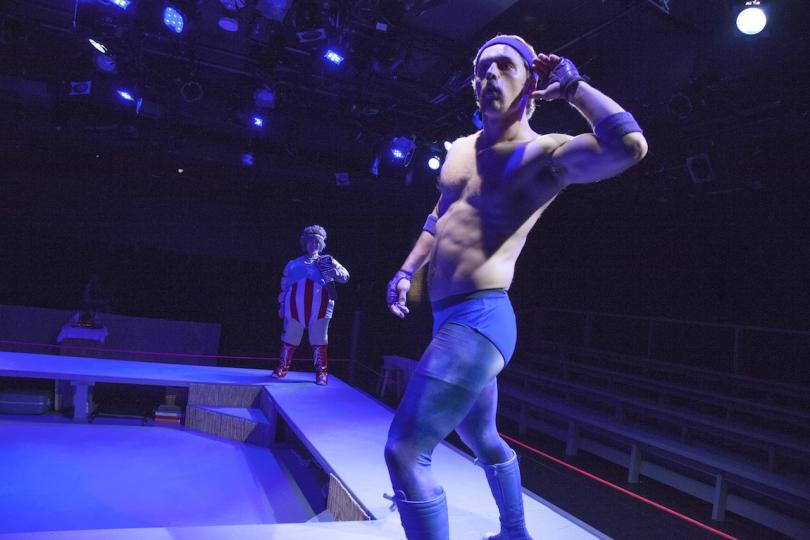American dreaming, in the ring

Hulk Hogan’s brand is in shambles these days, but for a strange, surprisingly lengthy stretch not so long ago, the man was the closest thing American kids had to a real-life superhero. In his 1980s prime, Hogan was the muscle-bound, flaxen-maned, moustache-rocking flagship property of one of the nation’s weirdest and most lucrative sporting enterprises. He was everything a lonely, socially awkward Filipino kid from a working-class immigrant family wasn’t, which is what earns him title-billing in Mu Performing Arts’s world premiere production of tot: The Untold, Yet Spectacular Story of (a Filipino) Hulk Hogan.
Actually, that’s rather an outsized title for a play this intimate and heartfelt. Playwright Victor Maog’s debut feature follows the titular Tot (Randy Reyes), a little boy growing up with an elderly relative (Mary Ann Prado) in the Ferdinand Marcos-controlled Philippines while his parents build a new life in the United States.
When he’s finally called to join them in America, very much against his wishes, he struggles to fit in with his mother’s (Hope Nordquist) tireless work ethic, his father’s (Eric “Pogi” Sumangil) pipe dream of show-biz stardom, and his younger sister’s (Stephanie Bertumen, Reyes’s real-life sister) easy Americanization. Tot’s only refuge from familial discord and chronic homesickness is the elaborate wrestling-themed fantasy world he constructs in his bedroom. He can and frequently does rattle off the names of all the real-life WWF superstars of the early ‘80s, but he’s never more at home than when he’s breathing life into his own fabricated federation.
Original yet familiar
There’s a lot about tot that feels familiar. A coming-of-age story about a young immigrant finding solace in an unexpected elements of his adopted homeland isn’t exactly new territory, but there are still plenty of original and eccentric elements to go around here. The most noticeable of those is Sarah Brandner’s set design, which turns Park Square’s Boss Thrust Stage into a wrestling ring in the round.
In the show’s early going that design seems mostly like a clever flourish. When Tot’s imagination takes over, though, the ring comes to life as the boy casts his family members as costumed superstars: his father as the federation’s vainglorious founder and announcer, his mother as the quietly competent enforcer, and his sister as a blonde buffoon in a red-white-and-blue singlet.
The only family member who doesn’t make an appearance in the ring is Tot himself. Instead, he channels his aspirations into a buff, eager-to-please body-slammer who also happens to be the only non-Filipino in the federation. Torsten Johnson’s pointedly guileless performance as Tot’s Hulk Hogan stand-in is a clever, evocative expression of the boy’s struggle to assimilate into a world where the few things he admires could hardly be further from his own experience. It’s telling that the aspect of American culture that resonates most with Tot is one specifically designed as a cartoonish distortion of reality.
Child-like yet credible
Much of the show’s success rests on the shoulders of lead actor Randy Reyes, who also co-directs the show along with Ellen Fenster. Watching an adult actor play a child is often a dicey proposition, but Reyes approaches Tot with such confidence and contemplation that any dissonance evaporates almost immediately. It’s a remarkable physical performance, with Reyes capturing the restless fidgeting and petulant body language of an anxiety-ridden eight-year-old without going over the top.
Maog’s script likewise treats Tot as a confused and frustrated child, avoiding the all too common trappings of theatrical kids who talk and act like miniature adults. He quietly claims a place as one of the more memorable characters of the season.
While tot isn’t a flawless theatrical experience - as mentioned before, the narrative is familiar, and the action sometimes feels repetitive - it’s a thoroughly enjoyable show that doesn’t settle for easy choices. Maog, Reyes and Fenster inject the proceedings with an upbeat energy that jostles satisfyingly against the play’s marked avoidance of unearned happy endings.
As the culture clashes and identity crises grow more and more complex, tot refuses to pick a side, possibly because there’s simply no right side to pick. That’s some heady stuff for a play that draws its name and a good chunk of its inspiration from the star of Santa with Muscles, but American dreams come in all sizes and shapes, some more attainable than others.




